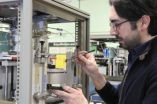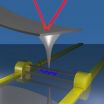(Press-News.org) WEST LAFAYETTE, Ind. - The smallest wires ever developed in silicon - just one atom tall and four atoms wide - have been shown by a team of researchers from the University of New South Wales, Melbourne University and Purdue University to have the same current-carrying capability as copper wires.
Experiments and atom-by-atom supercomputer models of the wires have found that the wires maintain a low capacity for resistance despite being more than 20 times thinner than conventional copper wires in microprocessors.
The discovery, which was published in this week's journal Science, has several implications, including:
For engineers it could provide a roadmap to future nanoscale computational devices where atomic sizes are at the end of Moore's law. The theory shows that a single dense row of phosphorus atoms embedded in silicon will be the ultimate limit of downscaling.
For computer scientists, it places donor-atom based silicon quantum computing closer to realization.
And for physicists, the results show that Ohm's Law, which demonstrates the relationship between electrical current, resistance and voltage, continues to apply all the way down to an atomic-scale wire.
Bent Weber, the paper's lead author and a graduate student in the Centre of Excellence for Quantum Computation and Communication Technology at the University of New South Wales, was thrilled with the finding.
"It's extraordinary to show that Ohm's Law, such a basic law, still holds even when constructing a wire from the fundamental building blocks of nature - atoms," he says.
The innovation of the Australian group was to build the circuits up atom by atom, instead of the current method of building microprocessors, in which material is stripped away, says Gerhard Klimeck, a Purdue professor of electrical and computer engineering and director of the Network for Computational Nanotechnology.
"Typically we chip or etch material away, which can be very expensive, difficult and inaccurate," Klimeck says. "Once you get to 20 atoms wide you have atomic flucuations that make scaling difficult. But this experimental group built devices by placing atomically thin layers of phosphorus in silicon and found that with densely doped phosphorus wires just four atoms wide it acts like a wire that conducts just as well as metal."
The goal of the research is to develop future quantum computers in which single atoms are used for the computation, says Michelle Simmons, director of the Centre of Excellence for Quantum Computation and Communication Technology at the University of New South Wales and the project's principal investigator.
"We are on the threshold of making transistors out of individual atoms," Simmons says. "But to build a practical quantum computer we have recognized that the interconnecting wiring and circuitry also needs to shrink to the atomic scale."
Hoon Ryu, a Purdue graduate who is now a senior researcher with the Korea Institute of Science and Technology's Supercomputing Center, said the practicality of the research is exciting.
"The metallic wire is in principle quite difficult to be scaled into one- to two-nanometer pitch, but in both experimental and modeling views, the research result is quite remarkable," Ryu says. "For the first time, this demonstrates the possibility that densely doping wire is a viable alternative for the next-gerenation, ultra-scale metallic interconnect in silicon chips."
To assist the Australian researchers, Klimeck's research team ran hundreds of simulations to study the variability of these nanoscale structures.
"Having the throughput capability for a highly scalable code is important for doing that, and we have that capability here at Purdue with http://nanoHUB.org," Klimeck says. "We ran hundreds of cases to understand the potential landscape of these devices, so this was computationally intensive work."
Klimeck says that in addition to the project's scientific and engineering implications, he found the collaboration the most rewarding aspect.
"It is an exciting collaboration," he says. "We were doing simulations of experimental work, which was based on a theoretical model. So we were bringing the three legs of modern science together in one project. Plus, our graduate students are able to stay in contact and work with each other despite working in various locations around the world. It's hard to think of a better example of how science is done today."
INFORMATION:
Writer: Steve Tally, 765-494-9809, tally@purdue.edu, Twitter: sciencewriter
Media contacts: Greg Kline, 765-494-8167, gkline@purdue.edu
University of New South Wales media contact: Mary O╒Malley, 0438 881 124, m.omalley@unsw.edu.au
Sources: Michelle Simmons, 0425 336 756 michelle.simmons@unsw.edu.au
Gerhard Klimeck, 765-494-9212, gekco@purdue.edu
Hoon Ryu, elec1020@gmail.com
Related websites:
Centre of Excellence for Quantum Computation and Communication Technology at the University of South Wales: http://www.cqc2t.org
Network for Computational Nantechnology, nanoHUB, Purdue University: https://www.ncn.purdue.edu/
Michelle Simmons: http://www.cqc2t.org/biography/98
Gerhard Klimeck: http://nanoHUB.org/klimeck
IMAGE CAPTION:
Wires just one atom tall have been created by inserting a string of phosphorus atoms in a silicon crystal by a team of researchers from the Univeristy of New South Wales, Melbourne Univeristy and Purdue University. This image from a computational simulation run of the wires shows electron density as electrons flow from left to right. The wires are 20 times smaller than the smallest wires now available and measure just four atoms wide by one phosphorus atom tall. (Purdue University image/Sunhee Lee, Hoon Ryu and Gerhard Klimeck)
http://news.uns.purdue.edu/images/2012/klimeck-phosphorus.jpg
Abstract on the research in this release is available at: http://www.purdue.edu/newsroom/research/2012/120105KlimeckPhosphorus.html
Down to the wire for silicon: Researchers create a wire 4 atoms wide, 1 atom tall
2012-01-09
ELSE PRESS RELEASES FROM THIS DATE:
Proton therapy effective prostate cancer treatment
2012-01-09
Proton therapy, a type of external beam radiation therapy, is a safe and effective treatment for prostate cancer, according to two new studies published in the January issue of the International Journal of Radiation Oncology•Biology•Physics (Red Journal), the American Society for Radiation Oncology's (ASTRO) official scientific journal.
In the first study, researchers at the University of Florida in Jacksonville, Fla., prospectively studied 211 men with low-, intermediate-, and high-risk prostate cancer. The men were treated with proton therapy, a specialized type of ...
ISU scientist helps find structure of gene-editing protein named Method of the Year
2012-01-09
AMES, Iowa – In the two and a half years since Adam Bogdanove, professor at Iowa State University in the Department of Plant Pathology and Microbiology, along with Matthew Moscou, a former graduate student in that department, discovered how a class of proteins from plant pathogenic bacteria find and bind specific sequences in plant genomes, researchers worldwide have moved fast to use this discovery.
Last year it was first shown that the proteins can be fused to DNA modifying enzymes to manipulate genes and gene functions by Bogdanove and colleagues at the University ...
Flatworm flouts fundamental rule of biology
2012-01-09
A tiny, freshwater flatworm found in ponds and rivers around the world that has long intrigued scientists for its remarkable ability to regenerate has now added a new wrinkle to biology.
Reporting in the journal Science today, researchers at the University of California, San Francisco (UCSF) and the Stowers Institute for Medical Research in Kansas City, MO, have discovered that the worm lacks a key cellular structure called a "centrosome," which scientists have considered essential for cell division.
Every animal ever examined, from the mightiest mammals to the lowliest ...
Earth's massive extinction: The story gets worse
2012-01-09
Scientists have uncovered a lot about the Earth’s greatest extinction event that took place 250 million years ago when rapid climate change wiped out nearly all marine species and a majority of those on land. Now, they have discovered a new culprit likely involved in the annihilation: an influx of mercury into the eco-system.
“No one had ever looked to see if mercury was a potential culprit. This was a time of the greatest volcanic activity in Earth’s history and we know today that the largest source of mercury comes from volcanic eruptions,” says Dr. Steve Grasby, co-author ...
3-dimensional view of 1-dimensional nanostructures
2012-01-09
Just 100 nanometers in diameter, nanowires are often considered one-dimensional. But researchers at Northwestern University have recently reported that individual gallium nitride nanowires show strong piezoelectricity – a type of charge-generation caused by mechanical stress – in three dimensions.
The findings, led by Horacio Espinosa, James N. and Nancy J. Farley Professor in Manufacturing and Entrepreneurship at the McCormick School of Engineering and Applied Science, were published online Dec. 22 in Nano Letters.
Gallium nitride (GaN) is among the most technologically ...
Another outbreak of coral disease hits the reefs of Kane'ohe Bay, O'ahu
2012-01-09
In March 2010 an outbreak of a disease called acute Montipora White Syndrome (MWS) was discovered affecting coral reefs in Kaneohe Bay, Oahu. Follow-up surveys found that the disease left trails of rubble in its wake. It was estimated that over 100 colonies of rice coral (Montipora capitata) died during that initial outbreak. The disease has reappeared and is killing corals in Kaneohe Bay. The current outbreak has already affected 198 colonies and a rapid response team led by Dr. Greta Aeby (HIMB) has been activated to document the outbreak. Members of the investigative ...
Moderate red wine drinking may help cut women's breast cancer risk, Cedars-Sinai study shows
2012-01-09
LOS ANGELES – Drinking red wine in moderation may reduce one of the risk factors for breast cancer, providing a natural weapon to combat a major cause of death among U.S. women, new research from Cedars-Sinai Medical Center shows.
The study, published online in the Journal of Women's Health, challenges the widely-held belief that all types of alcohol consumption heighten the risk of developing breast cancer. Doctors long have determined that alcohol increases the body's estrogen levels, fostering the growth of cancer cells.
But the Cedars-Sinai study found that ...
A large subgroup of mild-to-moderate asthma is persistently non-eosinophilic
2012-01-09
A large percentage of patients with mild-to-moderate asthma have persistently non-eosinophilic disease which may not respond to currently available anti-inflammatory treatments, according to a new study.
In a cross-sectional study of 995 asthmatic subjects enrolled in nine clinical trials conducted by the NHLBI's Asthma Clinical Research Network, sputum eosinophilia (≥2% eosinophils) was
found in only 36% of asthmatics not using an inhaled corticosteroid (ICS) and 17% of those using an ICS. Among patients who achieved good asthma control, 26% had sputum eosinophilia, ...
Statins may increase risk of interstitial lung abnormalities in smokers
2012-01-09
Use of statins may influence susceptibility to or the progression of interstitial lung disease (ILD) in smokers, according to a new study.
While some studies have suggested that statins might be beneficial in the treatment of fibrotic lung disease, others have suggested that they may contribute to the progression of pulmonary fibrosis by enhancing secretion of inflammasome-regulated cytokines, and numerous case reports have suggested that statins may contribute to the development of various types of ILD.
"Based on earlier case reports of statin-associated ILD and data ...
Study shows no evidence of a mortality benefit to PSA screening
2012-01-09
Men enrolled in the Prostate, Lung, Colorectal and Ovarian Cancer (PLCO) Screening Trial had no evidence of a mortality benefit compared to a control group of men undergoing usual care, according to a study published online Jan. 6 in the Journal of the National Cancer Institute.
The Prostate, Lung, Colorectal and Ovarian Cancer Screening (PLCO) Trial is a multi-center, two-arm trial, which began enrollment in November 1993 with follow-up through December 2009, and was designed to evaluate the effect of screening on these specific cancers. The enrollees were aged 55-74 ...


